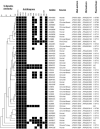Characterization of extended-spectrum cephalosporin-resistant Salmonella enterica serovar Heidelberg isolated from food animals, retail meat, and humans in the United States 2009
- PMID: 22755514
- PMCID: PMC4620655
- DOI: 10.1089/fpd.2012.1130
Characterization of extended-spectrum cephalosporin-resistant Salmonella enterica serovar Heidelberg isolated from food animals, retail meat, and humans in the United States 2009
Abstract
Salmonella enterica is one of the most common causes of foodborne illness in the United States. Although salmonellosis is usually self-limiting, severe infections typically require antimicrobial treatment, and ceftriaxone, an extended-spectrum cephalosporin (ESC), is commonly used in both adults and children. Surveillance conducted by the National Antimicrobial Resistance Monitoring System (NARMS) has shown a recent increase in ESC resistance among Salmonella Heidelberg isolated from food animals at slaughter, retail meat, and humans. ESC resistance among Salmonella in the United States is usually mediated by a plasmid-encoded bla(CMY) β-lactamase. In 2009, we identified 47 ESC-resistant bla(CMY)-positive Heidelberg isolates from humans (n=18), food animals at slaughter (n=16), and retail meats (n=13) associated with a spike in the prevalence of this serovar. Almost 90% (26/29) of the animal and meat isolates were isolated from chicken carcasses or retail chicken meat. We screened NARMS isolates for the presence of bla(CMY), determined whether the gene was plasmid-encoded, examined pulsed-field gel electrophoresis patterns to assess the genetic diversities of the isolates, and categorized the bla(CMY) plasmids by plasmid incompatibility groups and plasmid multi-locus sequence typing (pMLST). All 47 bla(CMY) genes were found to be plasmid encoded. Incompatibility/replicon typing demonstrated that 41 were IncI1 plasmids, 40 of which only conferred bla(CMY)-associated resistance. Six were IncA/C plasmids that carried additional resistance genes. pMLST of the IncI1-bla(CMY) plasmids showed that 27 (65.8%) were sequence type (ST) 12, the most common ST among bla(CMY)-IncI1 plasmids from Heidelberg isolated from humans. Ten plasmids had a new ST profile, ST66, a type very similar to ST12. This work showed that the 2009 increase in ESC resistance among Salmonella Heidelberg was caused mainly by the dissemination of bla(CMY) on IncI1 and IncA/C plasmids in a variety of genetic backgrounds, and is likely not the result of clonal expansion.
Figures

Similar articles
-
Characterization of extended-spectrum cephalosporin-resistant Salmonella enterica serovar Heidelberg isolated from humans in the United States.Foodborne Pathog Dis. 2010 Feb;7(2):181-7. doi: 10.1089/fpd.2009.0376. Foodborne Pathog Dis. 2010. PMID: 19785533
-
Characterization of bla(CMY)-encoding plasmids among Salmonella isolated in the United States in 2007.Foodborne Pathog Dis. 2011 Dec;8(12):1289-94. doi: 10.1089/fpd.2011.0944. Epub 2011 Sep 1. Foodborne Pathog Dis. 2011. PMID: 21883005
-
A Whole-Genome Sequencing Approach To Study Cefoxitin-Resistant Salmonella enterica Serovar Heidelberg Isolates from Various Sources.Antimicrob Agents Chemother. 2017 Mar 24;61(4):e01919-16. doi: 10.1128/AAC.01919-16. Print 2017 Apr. Antimicrob Agents Chemother. 2017. PMID: 28137797 Free PMC article.
-
Occurrence of β-lactamase genes among non-Typhi Salmonella enterica isolated from humans, food animals, and retail meats in the United States and Canada.Microb Drug Resist. 2013 Jun;19(3):191-7. doi: 10.1089/mdr.2012.0178. Epub 2013 Jan 5. Microb Drug Resist. 2013. PMID: 23289438
-
Antimicrobial resistance in Salmonella enterica serovar Heidelberg isolates from retail meats, including poultry, from 2002 to 2006.Appl Environ Microbiol. 2008 Nov;74(21):6656-62. doi: 10.1128/AEM.01249-08. Epub 2008 Aug 29. Appl Environ Microbiol. 2008. PMID: 18757574 Free PMC article.
Cited by
-
Integrated Surveillance for Antimicrobial Resistance in Salmonella From Clinical and Retail Meat Sources Reveals Genetically Related Isolates Harboring Quinolone- and Ceftriaxone-Resistant Determinants.Open Forum Infect Dis. 2021 Apr 26;8(8):ofab213. doi: 10.1093/ofid/ofab213. eCollection 2021 Aug. Open Forum Infect Dis. 2021. PMID: 34409121 Free PMC article.
-
Epidemiology of Salmonella enterica Serotype Dublin Infections among Humans, United States, 1968-2013.Emerg Infect Dis. 2017 Sep;23(9):1493-501. doi: 10.3201/eid2309.170136. Emerg Infect Dis. 2017. PMID: 28820133 Free PMC article.
-
Multiple Displacement Amplification as a Solution for Low Copy Number Plasmid Sequencing.Front Microbiol. 2021 Feb 11;12:617487. doi: 10.3389/fmicb.2021.617487. eCollection 2021. Front Microbiol. 2021. PMID: 33643244 Free PMC article.
-
Extended-Spectrum Cephalosporin-Resistant Salmonella enterica serovar Heidelberg Strains, the Netherlands(1).Emerg Infect Dis. 2016 Jul;22(7):1257-61. doi: 10.3201/eid2207.151377. Emerg Infect Dis. 2016. PMID: 27314180 Free PMC article.
-
Phenotypic and Genotypic Characterization of Animal-Source Salmonella Heidelberg Isolates.J Vet Med. 2016;2016:6380890. doi: 10.1155/2016/6380890. Epub 2016 Jan 3. J Vet Med. 2016. PMID: 26881274 Free PMC article.
References
-
- Baudry PJ, Mataseje L, et al. Characterization of plasmids encoding CMY-2 AmpC beta-lactamases from Escherichia coli in Canadian intensive care units. Diagn Microbiol Infect Dis. 2009;65(4):379–383. - PubMed
-
- Carattoli A, Bertini A, et al. Identification of plasmids by PCR-based replicon typing. J Microbiol Methods. 2005;63(3):219–228. - PubMed
-
- Centers for Disease Control and Prevention. National Antimicrobial Resistance Monitoring System for Enteric Bacteria (NARMS): Enteric Bacteria Annual Report 2009
-
- CLSI. Performance Standards for Antimicrobial Susceptibility Testing; Twenty-first Informational Supplement CLSI Document M100-S21. Clinical and Laboratory Standards Institute; 2011.
Publication types
MeSH terms
Substances
Grants and funding
LinkOut - more resources
Full Text Sources
Other Literature Sources

